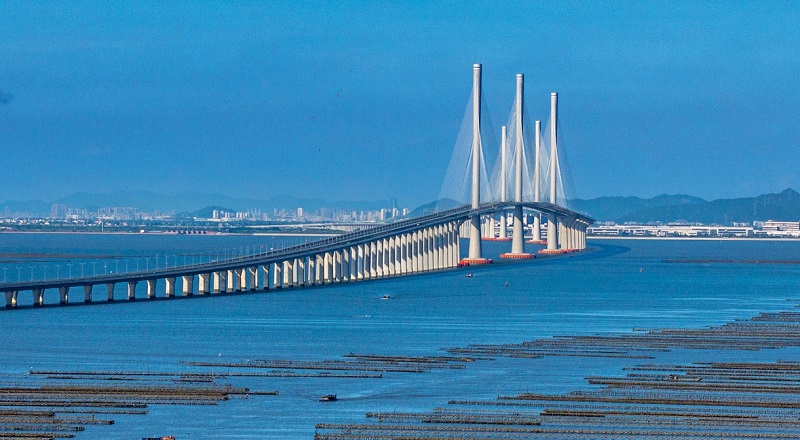Chinese modernization transcends the conventional concept of modernization, as the Chinese wisdom behind it inspires innovative development.
For a long time, many people have equated modernization with Westernization. This long held prejudice has proven false in the face of Chinese modernization.
Deeply rooted in its 5,000-year civilization, China has embarked on a unique development path fitting its national conditions, cultural traditions, and developmental needs. This path not only prioritizes economic growth but also emphasizes social equity, ecological conservation, and sustainable development, offering valuable lessons for other nations worldwide, particularly developing countries.

Neatly aligned facilities of aquaculture farms can be seen in the foreground of the Huangmao Sea Channel Bridge in Jiangmen, Guangdong Province, on June 9, 2025.
Cultural Roots
China has a time-honored civilization and rich cultural heritage, which have crystalized into a wealth of wisdom, exemplified primarily in the philosophies of Confucianism, Taoism, and Legalism.
Confucianism insists on “putting the people first” and “promoting harmony among all nations.” Taoism emphasizes “harmony between humanity and nature” and “observance of the laws of nature.” Legalism champions “rule by law.” These philosophies have not only shaped Chinese values and spirit but also served as the cultural guidance for Chinese modernization. This represents the integration of traditional culture with modern governance.
Chinese modernization transcends the conventional concept of modernization, as the Chinese wisdom behind it inspires innovative development. This wisdom has far-reaching influence in all sectors of the Chinese society, ranging from state governance, economic growth and social management, to international cooperation, technological innovation, and green development.
People-Centered Modernization
Modernization cannot be achieved without the cultivation of modern citizens. To achieve Chinese modernization, we must follow a people-centered approach, promote all-round human development, fairness and justice, and strive for common prosperity.
As early as over 2,000 years ago, Confucian scholars held the view that, “The people are the foundation of the state,” asserting that the governance of a state is fundamentally about ensuring the well-being of its people. The scholars hence advocated for fair distribution of wealth to narrow the gap between the rich and the poor, and pursue both shared interests and the greater good. These ideas have been incorporated into Chinese modernization, and in addition to economic growth, it places greater emphasis on social equity to ensure that the fruits of development benefit all people.
Global Governance
The term “harmony among all nations” originated in the Book of Documents, expressing the desire that countries should coexist peacefully, build inclusive, cooperative ties, and pursue shared development. It is based on this idea that China proposed to build a global community of shared future.
China believes that all nations, regardless of size or the distance between them, should respect, learn from, and live in peace with each other. Together we should build a world of lasting peace, universal security, and common prosperity. This vision represents China’s solution to advancing global cooperation and fostering a more equitable, just, and balanced international order.
Green Development
Harmony between humanity and nature is a core tenet of Taoism, emphasizing that, “All living things may grow side by side without harming one another.” It resonates with the famous remarks of President Xi Jinping, “Lucid waters and lush mountains are invaluable assets.” Guided by this vision, Chinese modernization highlights the balance between ecological conservation and economic development. In the pursuit of economic prosperity, a nation should protect its natural environment to achieve sustainable development.
As our planet is grappling with escalating climate change and ecological crises, green, low-carbon development has become a worldwide consensus. The concept “harmony between humanity and nature” aligns closely with this consensus. It properly defines the relationship between humans and nature: we are not masters of nature, but an integral part of it. Only by respecting, adapting to, and protecting nature can we realize harmonious coexistence and ensure the long-term progress of human society.
Rule of Law
The Legalist principle of “rule by law” advocates using law as the primary means of national governance. It emphasizes that a state must be governed by law rather than any individual’s will or traditional ethics. This principle has been advanced and applied in China's modernization drive.
Chinese modernization not only considers economic development but also a fair society operating under a sound, complete legal system. Rule of law is both a fundamental policy for national governance and a vital safeguard for social stability and people's well-being. Only by establishing the rule of law as a societal consensus can China achieve enduring stability, social progress and harmony.
Global Significance
The Chinese path to modernization is grounded in China’s rich cultural heritage and draws on both traditional wisdom and modern ideas. It not only encapsulates China’s own developmental experience but also global wisdom about state governance.
Today, we are facing a complex and volatile global geopolitical landscape — marked by regional conflicts, environmental degradation, unilateralism, protectionism, and power politics. With this as a backdrop, Chinese modernization has allowed China to make successful socioeconomic transformation and sustained progress. Meanwhile, it presents the international community with a development path distinct from those in the West, bringing new experience, opportunities, and hope for global development. 
KOH KING KEE is president of the Centre for New Inclusive Asia.
(The Chinese edition of this article was published on chinadiplomacy.org.cn)